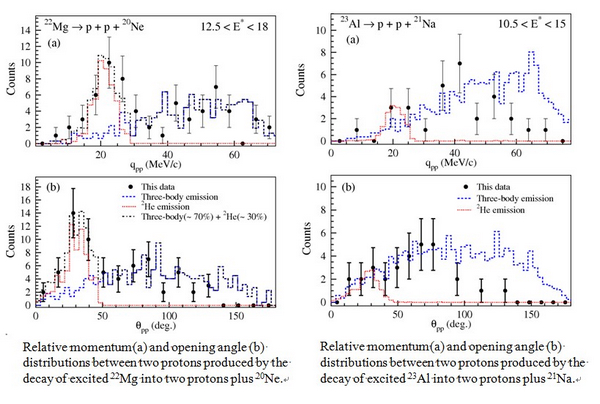






Recently, the rare 2He-cluster emission near the 14.044 MeV excited state of 22Mg was observed in the measurement of two-proton emission for proton-rich nucleus 22Mg by Prof. Ma Yugang’s group from Shanghai Institute of Applied Physics collaborated with Institute of Modern Physics, Institute of Physical and Chemical Research (RIKEN), Japan, etc. In contrast, there was no obvious 2He-cluster emission from the neighboring proton-rich nucleus 23Al. These results are very helpful for the understanding on the characteristic of proton-rich nuclei. The work was published in Phys. Lett. B 743, 306 (2015).
Since the discovery of natural radioactivity of Uranium by the French physicist Becquerel in 1896, researches on nuclear radioactivity were started. Complete new understanding on the microscopic structure of matter was obtained and a door to nuclear physics was opened since this discovery. α、β and γ decays are the classical decay ways of unstable nuclei. However, two-proton (2p) emission, i.e., proton-rich nucleus decays by the emission of two protons at the same time, is an exotic decay way for the proton-rich nucleus close to the drip-line, which was predicted over sixty year ago. Generally, three ways for proton-rich nuclei to emit two protons are possible: (i) two-body sequential emission in a short time; (ii) three-body simultaneously democratic emission; and (iii) 2He-cluster emission and then breakup into two protons. The 2He-cluster in case (iii) is basically two protons constrained by the pair correlation in a quasi-bound s-singlet, i.e., 1S0 configuration. In the first two ways, almost two independent protons are emitted. While for the third way, two protons with strong initial correlation are emitted. Thus 2He-cluster emission is a particular process that people are really interested in. Studying the two-proton correlation provides a good tool to understand the nucleon-nucleon pair-correlation inside a nucleus and other related topics like the BCS-BEC crossover. In addition, it is a good door for investigating the astro-nuclear (2p,γ), and (γ,2p) processes which are closely related to the waiting point nuclei. Although some experimental investigations on the 2p emitter have been done, the two-proton decay mechanism is still not well understood and further experimental and theoretical studies are required.
The experimental team of Prof. Ma Yugang’s group from Shanghai Institute of Applied Physics, together with collaborators from Institute of Modern Physics and Japan, performed measurements of two-proton emission from the excited proton-rich nuclei 22Mg and 23Al on the projectile fragment separator (RIPS) at the RIKEN RI Beam Factory. The secondary 22Mg and 23Al beams were generated by projectile fragmentation of 135A MeV 28Si primary beam on 9Be production target and then selected and transported to the reaction Chamber through RIPS beam line. 22Mg and 23Al were excited by bombarding on a 12C reaction target and then two protons could be emitted. The residue and two protons were detected by five layers of silicon detectors and three layers of plastic hodoscopes. The first two layers of Si-strip detectors located around 50 cm downstream of the target were used to measure the emitting angle of the residue and protons. Three layers of single-electrode Si were used as the energy loss detectors for the residue. Each Si-strip layer consists of 5?5 matrix without detectors in the four corners. While each element Si layer consists of 3?3 matrix. Three layers of plastic hodoscopes located around 3 m downstream of the target were used as the energy loss detectors for protons. Time-of-flight (TOF) measured by the first layer of plastic hodoscope was used to determine the momentum of proton. Relative momentum and opening angle distributions between two protons emitted from excited 22Mg and 23Al were obtained through detailed data analysis. The excitation energy of 22Mg and 23Al were reconstructed by the difference between the invariant mass of three-body decay channel and mass of the mother nucleus in the ground state. By comparing the simulation of two-proton emission with the experimental data, it was found that the mechanism of two-proton emission from the excited states of 23Al was mostly sequential or three-body decay. For 22Mg, however, there has been experimental observation of two-proton emission from the 14.044 MeV state, but its mechanism is not clear due to low statistics. In this experiment, it was observed for the first time that there was 30% probability of 2He cluster emission near the 14.044 MeV excited state of 22Mg, the other 70% probability was sequential or three-body decay. This work provides the rare experimental data of 2He cluster emission, gives deeper understanding on the exotic properties of proton-rich nucleus, and is significant for the investigation of proton-proton correlation in proton-rich nuclei.
This work was partially supported by the Major State Basic Research Development Program and National Natural Science Foundation of China. (Provided by Nuclear Physics Division)
